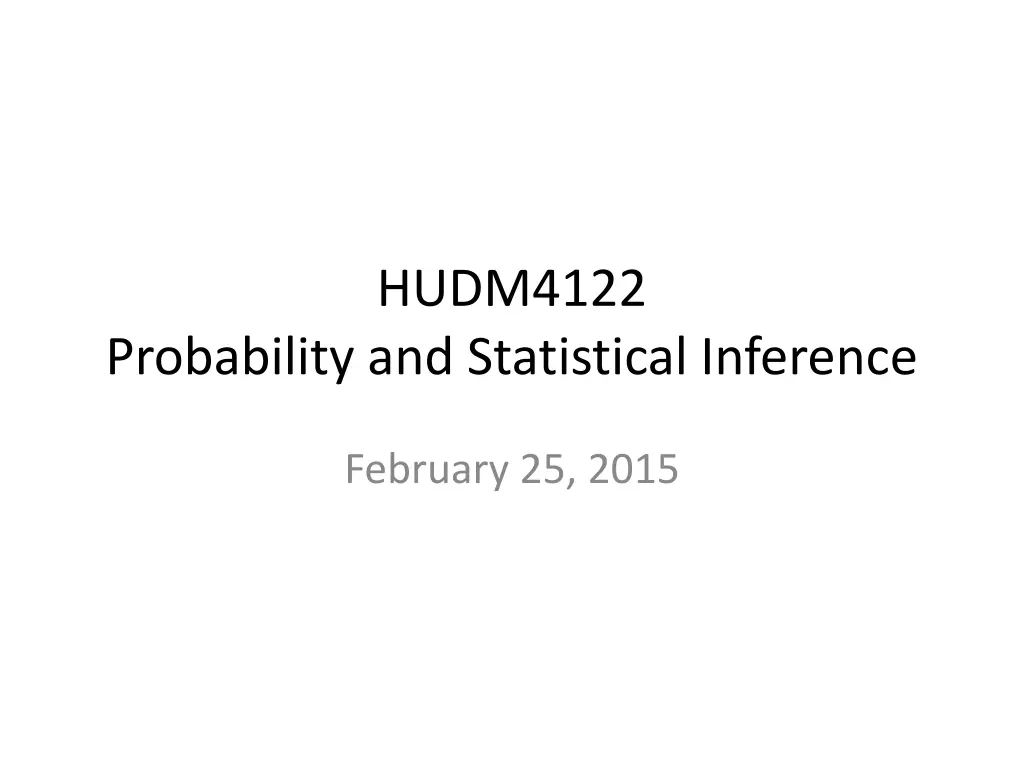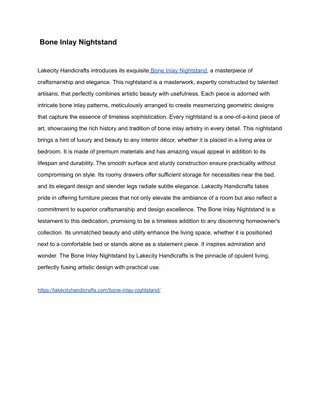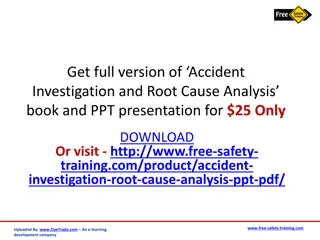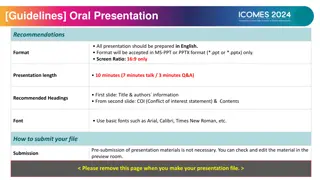
Statistics Practice Problems and Solutions
Explore a probability and statistical inference problem involving Yankee Doodle tune and student affect coding using the BROMP protocol. Understand Bayes' rule application and Law of Total Probability. Test your knowledge with these challenging exercises.
Download Presentation

Please find below an Image/Link to download the presentation.
The content on the website is provided AS IS for your information and personal use only. It may not be sold, licensed, or shared on other websites without obtaining consent from the author. If you encounter any issues during the download, it is possible that the publisher has removed the file from their server.
You are allowed to download the files provided on this website for personal or commercial use, subject to the condition that they are used lawfully. All files are the property of their respective owners.
The content on the website is provided AS IS for your information and personal use only. It may not be sold, licensed, or shared on other websites without obtaining consent from the author.
E N D
Presentation Transcript
HUDM4122 Probability and Statistical Inference February 25, 2015
HW You guys did well on this HW overall! Nice job!
Lets start with the one with the wrong answer In the famous words of U.S. President Ulysses S. Grant, "I only know two tunes: one of them is Yankee Doodle, and the other isn't." Let's say a band is playing a tune at the White House. In general, there's a 5% chance the tune is Yankee Doodle, and a 95% chance the tune isn't. President Grant observes that when the tune is Yankee Doodle, people sing along 70% of the time. When the tune isn't Yankee Doodle, people sing along 20% of the time. A tune is being played, and people are singing along. What's the probability that the tune is Yankee Doodle, given that people are singing along?
Mapping the variables A= singing S1 = Yankee Doodle S2 = Not Yankee Doodle
Bayes Rule A= singing S1 = Yankee Doodle S2 = Not Yankee Doodle ? ?1 ?(?|?1) ? ?1 ? = ? ?1 ? ? ?1 + ? ?2 ?(?|?2)
Plugging in Numbers A= singing S1 = Yankee Doodle S2 = Not Yankee Doodle (0.05)(0.7) ? ?1 ? = 0.05 0.7 + (0.95)(0.2)
Plugging in Numbers A= singing S1 = Yankee Doodle S2 = Not Yankee Doodle (0.05)(0.7) 0.05 0.7 +(0.95)(0.2)= 0.16 ? ?1 ? =
Any questions? Almost everyone got this one right and then got incorrected by the system
Difficult Problem A researcher is using the BROMP protocol for coding student affect in classroom settings. In BROMP, a researcher codes each student's affect in terms of a set of mutually exclusive categories. The observer finds that 25% of students are bored, 15% of students are frustrated, 10% of students are confused, and 30% of students are in a state of engaged concentration. If a student is bored, there is a 30% chance they are off-task. If a student is frustrated, there is a 10% chance they are off-task. If a student is confused, there is a 10% chance they are off-task. If a student is in a state of engaged concentration, there is a 5% chance they are off-task. Can the Law of Total Probability be applied in this case?
Whats the answer? A researcher is using the BROMP protocol for coding student affect in classroom settings. In BROMP, a researcher codes each student's affect in terms of a set of mutually exclusive categories. The observer finds that 25% of students are bored, 15% of students are frustrated, 10% of students are confused, and 30% of students are in a state of engaged concentration. If a student is bored, there is a 30% chance they are off-task. If a student is frustrated, there is a 10% chance they are off-task. If a student is confused, there is a 10% chance they are off-task. If a student is in a state of engaged concentration, there is a 5% chance they are off-task. Can the Law of Total Probability be applied in this case?
No, because B+F+C+E=80% and it needs to add to 100% A researcher is using the BROMP protocol for coding student affect in classroom settings. In BROMP, a researcher codes each student's affect in terms of a set of mutually exclusive categories. The observer finds that 25% of students are bored, 15% of students are frustrated, 10% of students are confused, and 30% of students are in a state of engaged concentration. If a student is bored, there is a 30% chance they are off-task. If a student is frustrated, there is a 10% chance they are off-task. If a student is confused, there is a 10% chance they are off-task. If a student is in a state of engaged concentration, there is a 5% chance they are off-task. Can the Law of Total Probability be applied in this case?
In the last class We studied Probability Distributions
Probability Distribution A probability distribution for random variable X gives the possible values of X, x1 xn And the probability p(xi) associated with each value of X Each value of X is mutually exclusive The sum of p(xi) adds to 1
Example I flip a coin twice The number of heads can be 0, 1, or 2 TT: 0 TH:1 HT:1 HH:2
Example I flip a coin twice The number of heads can be 0, 1, or 2 x P(x) TT: 0 TH:1 HT:1 HH:2 0 1/4 1 1/2 2 1/4
Probability Histogram x 0 1 2 P(x) 0.25 0.5 0.25 0.6 0.5 0.4 p(x) 0.3 0.2 0.1 0 0 1 x 2
Today Chapter 5.2 in Mendenhall, Beaver, & Beaver Binomial Probability Distribution
What we just looked at Was a binomial probability distribution
What we just looked at Was a binomial probability distribution A distribution coming out of two possible outcomes, repeated multiple times
Binomial Bi means two Like Biplane Plane with two wings Or Biathlon Two athletic events Or Bicorn An animal with two horns, seen in Harry Potter and My Little Pony
Where it comes from A binomial probability distribution comes from a binomial experiment
Examples You flip the same coin ten times and count the number of heads
Examples You flip the same coin ten times and count the number of heads You study the proportion of students in a school who are gang members
Examples You flip the same coin ten times and count the number of heads You study the proportion of students in a school who are gang members You study the proportion of Teachers College faculty who belong to the American Educational Research Association
Examples You flip the same coin ten times and count the number of heads You study the proportion of students in a school who are gang members You study the proportion of Teachers College faculty who belong to the American Educational Research Association (a.k.a gang members)
Examples You flip the same coin ten times and count the number of heads You study the proportion of students in a school who are gang members You study the proportion of Teachers College faculty who belong to the American Educational Research Association (a.k.a gang members) You study the number of students who have ever gotten an A+
Expanding it out You study 10,000 students, and count the number who have ever gotten an A+
Expanding it out You study 10,000 students, and count the number who have ever gotten an A+ Each trial is identical you select a student and see whether or not they have gotten an A+ There are two outcomes: Ever A+, Never A+ P(Ever A+) is the same across the population. The students are independent (if randomly sampled) You are interested in the number who have ever gotten an A+
Are these binomial experiments? Your friend throws a basketball 100 times; you want to see how often it goes in
Are these binomial experiments? Your friend throws a basketball 100 times; you want to see how often it goes in Yes
Are these binomial experiments? You take a bag of M&Ms with 5 green M&Ms out of 20 8 of your friends each takes an M&M out of the bag How many green M&Ms should you expect to get?
Are these binomial experiments? You take a bag of M&Ms with 5 green M&Ms out of 20 8 of your friends each takes an M&M out of the bag How many green M&Ms should you expect to get? No, because there is a finite pool of M&Ms, so the probability changes each time you take out an M&M
Are these binomial experiments? You ask 1,000 randomly sampled students if they have ever cheated on a test
Are these binomial experiments? You ask 1,000 randomly sampled students if they have ever cheated on a test Yes
Are these binomial experiments? Three candidates are running for political office. You randomly poll 1000 people as to who they plan to vote for, to see the proportion of probable voters for each candidate
Are these binomial experiments? Three candidates are running for political office. You randomly poll 1000 people as to who they plan to vote for, to see the proportion of probable voters for each candidate No, but it could easily be turned into a binomial experiment by just treating the data as Candidate A versus Not Candidate A
Are these binomial experiments? You randomly select 10,000 people and measure their height, to determine the average height in the population
Are these binomial experiments? You randomly select 10,000 people and measure their height, to determine the average height in the population No, because height is numerical rather than binomial
The Green M&M question Note that the difference between the Green M&M question and the other questions is that the Green M&M question had a small population We weren t looking at the population of all M&Ms We were looking at the population of M&Ms in that bag
Big populations and little populations If the sample size is close to the population size Then the probabilities will vary from trial to trial, and the experiment isn t binomial
Book Rule of Thumb Take sample size n Take population size N If n/N >= 0.05, do not treat experiment as binomial That 0.05 is a magic number We ll see it again later in the semester
Important Note P(S) and P(~S) do not have to be 0.5! They just have to be the same (or very very very close to the same) every time
Example Your friend throws a basketball 100 times; you want to see how often it goes in
Example Your friend throws a basketball 100 times; you want to see how often it goes in Perhaps, if your friend is DeAndre Jordan, P(S) = 72%
Example Your friend throws a basketball 100 times; you want to see how often it goes in Perhaps, if your friend is DeAndre Jordan, P(S) = 72% Perhaps, if your friend is Joe Fulks, the worst NBA player in the Hall of Fame (in terms of this statistic), P(S) = 30%
Example Your friend throws a basketball 100 times; you want to see how often it goes in Perhaps, if your friend is DeAndre Jordan, P(S) = 72% Perhaps, if your friend is Joe Fulks, the worst NBA player in the Hall of Fame (in terms of this statistic), P(S) = 30% Perhaps, if your friend is Ryan Baker, P(S) = 0.001%






















